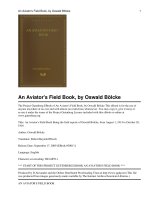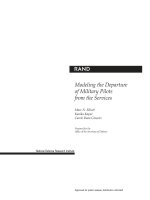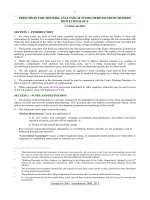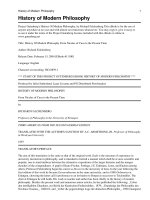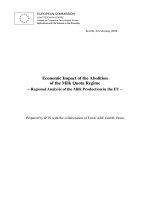Regional difference of alginates extracted from different brown seaweeds
Bạn đang xem bản rút gọn của tài liệu. Xem và tải ngay bản đầy đủ của tài liệu tại đây (2.01 MB, 64 trang )
REGIONAL DIFFERENCE OF ALGINATES
EXTRACTED FROM DIFFERENT BROWN SEAWEEDS
FENG TING
NATIONAL UNIVERSITY OF SINGAPORE
2014
Regional Difference of Alginates Extracted from
Different Brown Seaweeds
Feng Ting
(B. Sc., Sun Yat-sen University)
A THESIS SUBMITTED
FOR THE DEGREE OF MASTER OF SCIENCE
DEPARTMENT OF CHEMISTRY
NATIONAL UNIVERSITY OF SINGAPORE
2014
3
DECLARATION
I hereby declare that this thesis is my original work and it has been written by me in
its entirety, under the supervision of Prof. Sam Li Fong Yau, Departments of
Chemistry, National University of Singapore, between 04/08/2013 and 01/08/2014.
I have duly acknowledged all the sources of information which have been used in the
thesis.
This thesis has also not been submitted for any degree in any university previously.
Feng Ting
Name
Signature
1
04/08/2014
Date
Acknowledgement
We acknowledge financial support from the National Research Foundation and
Economic Development Board (SPORE, COY-15-EWI-RCFSA/N197-1) and
Shenzhen Development and Reform Commission (SZ DRC).
This one-year in Singapore means a lot to me. It is the first time for me to
experience foreign life, the first time to learn how to do the research, how to conduct
the experiments and finish a comprehensive project.
At first, I want to thank my supervisor, Prof. Sam Li, you are always kind and
nice to us. You allow me to chose my own interests and provide important help when
I need. Your smiles are always big courage, saying everything is possible.
I want to thank my mentor, Dr. Zhang Wenlin, everything becomes much more
easy and smooth just because of you. You are so patient, professional, smart and
capable to guide me with my project, train me how to use the equipment, and help me
solve the problems.
I want to thank my group members, Bao Hui, Karen, Si ni... thank my classmates,
my roommates, we share bitter and sweet together this whole year.
I want to thank National University of Singapore, providing such a good campus
for us to study, thank Department of Chemistry and NERI to provide us with all these
facilities. Moreover, I want to thank SPORE program, proving us the opportunity to
come here and enjoy all these harvests.
2
Table of Contents
SUMMARY .................................................................................................................. 5
1. BACKGROUND ...................................................................................................... 10
1.1 Introduction of seaweed ................................................................................. 10
1.2 Brown seaweed polysaccharides ................................................................... 12
1.3 Alginate extraction from brown seaweed ....................................................... 15
1.4 NMR and LC-MS analysis of polysaccharides .............................................. 16
1.5 Research approach ......................................................................................... 17
2. MATERIALS AND METHODS ................................................................................ 18
2.1 Materials ........................................................................................................ 18
2.2 Sample preparation ........................................................................................ 18
2.2.1 Brown seaweed sample preparation........................................................ 18
2.2.2 Alginate extraction .................................................................................. 19
2.2.3 NMR testing tube preparation ................................................................. 21
2.3 NMR Analysis................................................................................................. 22
2.3.1 NMR testing ............................................................................................ 22
2.3.2 Data analysis ........................................................................................... 23
2.4 LC-MS/MS analysis ....................................................................................... 24
2.4.1 Alginate oligosaccharide preparation ...................................................... 24
2.4.2 LC-MS analysis ...................................................................................... 25
3. RESULTS AND DISCUSSION .................................................................................. 27
3.1 NMR analysis results ..................................................................................... 27
3
3.1.1 Alginate extraction condition .................................................................. 27
3.1.2 NMR testing condition............................................................................ 29
3.1.3 NMR testing ............................................................................................ 30
3.2 LC-MS analysis results .................................................................................. 33
3.2.1 MS Analysis ............................................................................................ 33
3.2.2 LC Separation ......................................................................................... 43
4. CONCLUSION ........................................................................................................ 48
REFERENCES ............................................................................................................ 50
APPENDIX................................................................................................................. 57
4
Summary
Alginate, fucoidan and laminarin are the three main polysaccharides found in
brown seaweeds. They have various bioactive functions, such as antioxidant,
biocompatibility, non-toxicity and non-immunogenicity. Alginate has relatively large
molecular weight with high viscosity. It is composed of α-L-guluronic acid (G) block
and β-D-mannuronic acid (M) block units. The M and G blocks can form both
homo-polymeric and hetero-polymeric units. Different conformations and chemical
structures of M and G blocks will affect the bioactive functions of alginates.
Moreover, it has been indicated that growing conditions could influence the structure
formation. In order to analyze the regional difference, six brown seaweeds were
collected from different locations. Subsequently, alginates were extracted by alkaline
method. Saturated and unsaturated alginate oligosaccharides were also prepared by
acid hydrolysis and alginate lyase degradation, respectively. Then we applied NMR
and LC-MS/MS to detect both alginates and alginate oligosaccharides. The NMR
testing results of M and G block concentrations were represented by FM and FG values:
Podina from Malaysia belongs to high G species; Whereas Laminaria japonica from
Shandong and Fujian belongs to high M species; Laminaria saccharina from U.S.,
Laminaria digitata from Iceland, and Ascophyllum nodosum from Indonesia are
defined as intermediate alginates. Thus, Podina can provide brittle gel while the other
five species produce elastic gels. In addition, two Laminaria species from China have
similar M/G ratios, and Laminaria saccharina from U.S. and Laminaria digitata from
5
Iceland also have close M/G ratio. However, the concentrations of alginate solutions
extracted from all these six brown seaweeds are not high enough compared with the
alginate standard solution, thus the oligosaccharides are not successfully detected in
the LC-MS/MS study. Therefore, more efficient and optimal extraction methods
should be further explored to extract sufficient alginates for the analysis of the
chemical structure, bioactive function as well as regional difference.
6
List of Tables
Table 3-1 1H NMR chemical shifts of Laminaria japonica alginate with different
extraction temperatures ................................................................................................ 29
Table 3-2 1H NMR chemical shifts of Laminaria japonica alginate with different
extraction durations ...................................................................................................... 30
Table 3-3 1H NMR chemical shifts of six brown seaweed alginates under the same
extraction methods ....................................................................................................... 33
Table 3-4 Fragment ions observed in the product-ion spectra of unsaturated alginate
oligosaccharides ........................................................................................................... 36
Table 3-5 Optimizing conditions for MS scan of brown seaweed alginates ................ 38
Table 3-6 Fragment ions observed in the product-ion spectra of saturated alginate
oligosaccharides ........................................................................................................... 41
7
List of Figures
Fig. 1-1 Chemical structure of brown seaweed polysaccharides⋯⋯⋯⋯⋯⋯⋯⋯⋯13
Fig. 2-1 Extraction conditionds for brown seaweed alginates ⋯⋯⋯⋯⋯⋯⋯⋯⋯⋯22
Fig. 2-2 The NMR testing tubes of alginates from six different brown seaweeds⋯ 23
Fig. 2-3 1H NMR (600 MHz) spectra of alginate standard solutions (10 mg*mL-1) at
70 °C⋯⋯⋯⋯⋯⋯⋯⋯⋯⋯⋯⋯⋯⋯⋯⋯⋯⋯⋯⋯⋯⋯⋯⋯⋯⋯⋯⋯⋯⋯⋯⋯⋯⋯⋯⋯24
Fig. 3-1 1H NMR (600 MHz) spectra of alginate standard solutions (10 mg*mL-1) in
D2O with different extraction temperatures⋯⋯⋯⋯⋯⋯⋯⋯⋯⋯⋯⋯⋯⋯⋯⋯⋯⋯⋯28
Fig. 3-2 1H NMR (600 MHz) spectra of alginate standard solutions (10 mg*mL-1) in
D20 at different extraction durations⋯⋯⋯⋯⋯⋯⋯⋯⋯⋯⋯⋯⋯⋯⋯⋯⋯⋯⋯⋯⋯⋯30
Fig. 3-3 The selected process of extraction alginate from brown seaweeds⋯⋯ ⋯⋯ 31
Fig. 3-4 1H NMR (600 MHz) spectra of alginate standard solutions (10 mg*mL-1) in
D20 at different NMR testing temperatures⋯⋯⋯⋯⋯⋯⋯⋯⋯⋯⋯⋯⋯⋯⋯⋯⋯⋯⋯32
Fig. 3-5 1H NMR (600 MHz) spectra of poly-mannuronate and poly-guluronate
blocks of six different alginate solutions (10 mg*mL-1) in D20 by acid hydrolysis⋯ 32
Fig. 3-6 Comparison of 1H NMR (600 MHz) spectra of alginates solutions (10
mg*mL-1) in D20 extracted from laminarin japonica and alginate standard⋯⋯⋯⋯ 34
Fig. 3-7 Proposed fragmentation of unsaturated alginate oligosaccharides (AOS)
⋯⋯⋯⋯⋯⋯⋯⋯⋯⋯⋯⋯⋯⋯⋯⋯⋯⋯⋯⋯⋯⋯⋯⋯⋯⋯⋯⋯⋯⋯⋯⋯⋯⋯⋯⋯⋯⋯⋯36
Fig. 3-8 Precursor-ion spectra of 1ppm unsaturated AOS of alginate standard in 10
mM Ammonium Formate with 0.1% Formic Acid (50% A: 50% B) ⋯⋯⋯⋯⋯⋯⋯37
Fig. 3-9 Precursor-ion spectra of 1ppm unsaturated AOS of Laminaria japonica
(sample A) in 10 mM Ammonium Formate with 0.1% Formic Acid (50% A: 50% B)
⋯⋯⋯⋯⋯⋯⋯⋯⋯⋯⋯⋯⋯⋯⋯⋯⋯⋯⋯⋯⋯⋯⋯⋯⋯⋯⋯⋯⋯⋯⋯⋯⋯⋯⋯⋯⋯⋯⋯39
Fig. 3-10 Precursor-ion spectra of 5ppm unsaturated AOS of Laminaria japonica
(sample A) in 10 mM Ammonium Formate with 0.1% Formic Acid (50% A: 50% B)
⋯⋯⋯⋯⋯⋯⋯⋯⋯⋯⋯⋯⋯⋯⋯⋯⋯⋯⋯⋯⋯⋯⋯⋯⋯⋯⋯⋯⋯⋯⋯⋯⋯⋯⋯⋯⋯⋯⋯40
Fig. 3-11 Precursor-ion spectra of 10ppm unsaturated AOS of Laminaria japonica
(sample A) in 10 mM Ammonium Formate with 0.1% Formic Acid (50% A: 50% B)
⋯⋯⋯⋯⋯⋯⋯⋯⋯⋯⋯⋯⋯⋯⋯⋯⋯⋯⋯⋯⋯⋯⋯⋯⋯⋯⋯⋯⋯⋯⋯⋯⋯⋯⋯⋯⋯⋯⋯40
Fig. 3-12 Precursor-ion spectra of 1ppm saturated AOS diluted in 10 mM ammonium
formate with 0.1% Formic Acid (50% A: 50% B); alginates were hydrolyzed with
HCl (pH=2) for 180 min at 100 °C⋯⋯⋯⋯⋯⋯⋯⋯⋯⋯⋯⋯⋯⋯⋯⋯⋯⋯⋯⋯⋯⋯⋯42
Fig. 3-13 Precursor-ion spectra of 10ppm saturated AOS diluted in 10 mM
ammonium formate with 0.1% Formic Acid (50% A: 50% B); alginates were
hydrolyzed with HCl (pH=2) for 180 min at 100 °C⋯⋯⋯⋯⋯⋯⋯⋯⋯⋯⋯⋯⋯⋯⋯42
Fig. 3-14 Precursor-ion spectra of 1ppm saturated AOS diluted in 10 mM ammonium
acetate with 0.1% Formic Acid (50% A: 50% B); alginates were hydrolyzed with HCl
(pH=2) for 180 min at 100 °C⋯⋯⋯⋯⋯⋯⋯⋯⋯⋯⋯⋯⋯⋯⋯⋯⋯⋯⋯⋯⋯⋯⋯⋯⋯43
Fig. 3-15 Precursor-ion spectra of 1ppm saturated AOS diluted in 10 mM ammonium
acetate with 0.1% Formic Acid (50% A: 50% B); alginates were hydrolyzed with HCl
(pH=7) for 180 min at 100 °C⋯⋯⋯⋯⋯⋯⋯⋯⋯⋯⋯⋯⋯⋯⋯⋯⋯⋯⋯⋯⋯⋯⋯⋯⋯44
8
Fig. 3-16 LC separation of 1ppm unsaturated alginate oligosaccharide using
Phenomenex Luna HILIC (4.6 mm x 150 mm) column at 0.5 ml/min flow rate, 5ul
injection value at 35°C⋯⋯⋯⋯⋯⋯⋯⋯⋯⋯⋯⋯⋯⋯⋯⋯⋯⋯⋯⋯⋯⋯⋯⋯⋯⋯⋯⋯45
Fig. 3-17 LC separation of 1 ppm unsaturated alginate oligosaccharide using Tosoh
TSK gel Amide 3um (2.0 mm x 150 mm) column at 0.3 ml/min flow rate, 5ul
injection value at 35°C⋯⋯⋯⋯⋯⋯⋯⋯⋯⋯⋯⋯⋯⋯⋯⋯⋯⋯⋯⋯⋯⋯⋯⋯⋯⋯⋯⋯46
Fig. 3-18 LC separation of 1 ppm unsaturated alginate oligosaccharide using Tosoh
TSK gel Amide 3um (2.0 mm x 150 mm) column at 0.3 ml/min flow rate, 5ul
injection value at 40°C⋯⋯⋯⋯⋯⋯⋯⋯⋯⋯⋯⋯⋯⋯⋯⋯⋯⋯⋯⋯⋯⋯⋯⋯⋯⋯⋯⋯47
Figure 3-19 the LC separation of alginate oligosaccharide dimer (m/z=351.3) ⋯ ⋯ 47
Figure 3-20 the LC separation of alginate oligosaccharide trimer (m/z=527.1) ⋯ ⋯ 47
Fig. 3-21 the LC separation of alginate oligosaccharide tetramer (m/z=703) ⋯⋯ ⋯ 47
Fig. 3-22 the LC separation of alginate oligosaccharide pentameter (m/z=897) ⋯⋯ 47
Fig. 3-23 the LC separation of alginate oligosaccharide hexamer (m/z=1055) ⋯⋯⋯48
9
1. Background
1.1 Introduction of seaweed
Seaweeds are gaining more and more attentions in recent years as renewable
marine resource, with nearly six thousand seaweed species being identified to date [1].
They have no roots, leaves or vascular systems, and nourish themselves through
osmosis [2]. Seaweeds have been traditionally consumed as sea vegetables, especially
in Asian countries. In terms of output and value, seaweed cultivation is regarded to be
more important than any other aquatic plants in Asia, and 87% of the total global
seaweed cultivation lies in eastern Asia [3, 4]. Red seaweed, brown seaweed and
green seaweed are the three main species. Red seaweeds usually grow in tropical
areas while green and brown seaweeds are found in comparatively higher latitude,
such as eastern China, Japan and North America [5]. Generally, cold waters are much
better for more valuable brown seaweed cultivation, and the optimal water
temperature is around 20 °C [6].
Besides the regional distribution differences, brown, green and red seaweed
species also have different nutrient compositions and applications. For instance, red
seaweeds contain a high level of proteins (around 40% of dry weight for most of the
species), thus are generally used as additives for health care products. In contrast,
green seaweeds have lower protein level (around 10-25% of dry weight), hence they
are more suitable for biofuel production through bioethanol fermentation and
biodiesel extraction [7].
Brown seaweeds have the lowest protein content but the highest polysaccharides
composition [8]. For various brown seaweed species, the polysaccharide
concentrations range from 4% to 76% by dry weight [9]. The main polysaccharides of
brown seaweeds are cell wall structural and storage cells [3]. Due to the high
polysaccharides concentration, brown seaweeds contain diverse biological activities
in potential medicinal value, such as anti-viral, anti-coagulant, and anti-cancer [10,
11]. Despite all these valuable medicinal functions, most of the brown seaweeds are
just simply used for food or animal feed. In Europe, brown seaweeds are traditionally
used for producing additives or meals for animal nutrition [12]. In Asia, more than 60%
of the total seaweed consumptions are brown seaweeds, while less than 5% are used
for high nutritional products [13]. Moreover, in China, more than 90% of the
Laminaria japonica are directly harvested and washed for food and feed [14].
Actually, polysaccharides derived from brown seaweeds can play a more
important role in food, pharmaceuticals and other products [15]. For example, the
traditional anticoagulants heparin resources are decreasing sharply these years, it has
been indicated that new natural anticoagulants could be extracted from brown
seaweeds for safer therapy [16]. Thus it is necessary to explore cheap and valuable
alternative polysaccharides sources derived from brown seaweeds to replace the
existing bioactive compounds that have limited resource. However, the specific
functions and processes of extracting bioactive compounds form brown seaweeds are
not clear enough. Therefore, more comprehensive and systematic research will need
to be conducted to analyze and extend the potential pharmaceutical and health
11
applications of brown seaweed polysaccharides.
1.2 Brown seaweed polysaccharides
Fucose
Fucoidan
Laminarin
Alginic acid
Glucose
Mannuronate
Guluronate
Fig. 1-1 Chemical structure of brown seaweed polysaccharides [11]
Polysaccharides are a class of macromolecules consisting of various
oligosaccharides [12]. Laminarin, fucoidan and alginate are the three main
polysaccharides found in brown seaweeds. The different compositions and structural
activities of the three polysaccharides will affect the function of brown seaweeds.
Fucoidan, a unique class of polysaccharides solely found in brown seaweed,
consist fucose, galactose, and sulfate subunits (Fig. 1-1) [11, 17]. Fucoidan is an
expensive additive used in health care products for its bioactive properties such as
anti-adhesive, anti-complimentary, anti-oxidant, anti-proliferative and anti-viral
activities [18]. Laminarin is comprised of laminarin and glucose. Most laminarins are
considered as dietary fibers for human consumption because it is resistant to
hydrolysis [19].
Alginate is mainly located in brown seaweed cell wall and matrix [13]. It has
relatively high molecular weight. Alginate also has various bioactive properties, such
12
as antioxidant, biocompatibility, non-toxicity, and biodegradability and is widely used
among the most versatile biopolymers [20-22]. Alginate is highly viscous in aqueous
solution, and it can form gel in the presence of divalent cations such as calcium [23,
24]. This particular physicochemical characteristic provides alginate with great
potential in numerous applications such as food processing, cosmetics, and
pharmaceutical industries [25]. Different grades of alginate are available for specific
application: normal sodium alginates are used for industry application; high grade
ones are used for pharmaceutical and food use, for instance, drug delivery excipients,
wound dressings, and dental impression materials [26]. Some alginate coats of brown
seaweeds, such as P. aeruginosa, could provide protection from immune defense
system [27]. Moreover, alginate can protect against potential carcinogens and clear
the digestive system. Furthermore, large molecular weight alginates can also prevent
obesity, diabetes, and hypocholesterolemia[3].
In addition, alginate oligosaccharides (AOS) and their derivatives have specific
bioactive functions for applications as releasing agents in pharmacy and additives in
food industry [28, 29]. For instance, alginate oligosaccharides and their derivatives
can promote plant growth due to the anti-tumor function. Moreover, recent studies
have
indicated
that
enzymatically
depolymerized
unsaturated
alginate
oligosaccharides can cause increases in shoot elongation after germination of
Komatsuna [23]. In this case, more studies need to be devoted to analyze the
influence of oligosaccharide sequences on the biological and physicochemical
properties of alginates [30].
13
Alginate is an acidic linear polysaccharide composed of α-L-guluronic acid (G)
block and β-D-mannuronic acid (M) block units [29, 31, 32]. The M and G blocks can
join as both homopolymeric or heteropolymeric units in either one of three chains:
α-L-guluronic acid (G group), β-D-mannuronic acid (M group) or alternating units of
α-L-guluronic acid and β-D-mannuronic acid (MG group) [33]. The different
concentrations of M and G block and M/G ratios will all affect the bioactive activities
of alginate [28].
The M block forms β linkages to make linear and flexible conformation while the
G block forms α linkages to provide folded and rigid structural conformations
building steric hindrance around the carboxyl groups [20]. The different structure
distributions of M and G block along the polymer chain and the ratio of M/G could
affect the gel formation properties [25]. High-M concentration alginates form gels
quicker while G-rich alginates hold calcium thus form gels slowly [33]. In order to
comprehensively understand the chemical-physical properties and structure-function
relationships of alginates, we aim to identify the sequence structure of alginate
oligosaccharides [29, 34].
Besides the genetic factors affecting seaweed species, environmental factors
(such as water temperature and salinity) and harvesting season may also influence the
chemical compositions of brown seaweed polysaccharides [35]. Some research has
previously focused on the seasonal difference of brown seaweed polysaccharides [36,
37]. Taking the Laminaria species as an example, the maximum amounts of
polysaccharides are produced during summer and autumn, between June to November
14
[3]. Contrastingly, the winter harvests in February result in small amount or none
polysaccharides production, which indicated significant seasonal variations [3].
Similarly, the best harvesting seasons for other seaweed species also differ [38].
Alginates based industry started in the late 1800s, and was enlarged to
commercial scale since the 1930s [39]. At the very beginning, alginates were just
been used as food and food additions, and then paper producing industries and finally
in pharmaceuticals [33]. Each alginate has different functions depends on the different
chemical structures [40]. Unfortunately, even till now, the specific function based on
each alginate are not clear, more other underlying mechanisms of alginate
bioactivities are on the list waiting for research to explore [28]. Moreover, combining
with the environmental influences on alginate chemical structures, the various
bioactive functions of alginates extracted from different regions also worth
researching. The purpose of this study is to determine regional difference of alginates
as well as evaluate their potential applications.
1.3 Alginate extraction from brown seaweed
Generally, alginates are extracted by chemical, physical or biological methods,
such as acid hydrolysis, supercritical water hydrolysis, enzymatic digestion, thermal
degradation, microwave extraction, ultraviolet photolysis and oxidative–reductive
reactions [41-43]. Commercially available alginates are typically extracted from
brown seaweeds, including Laminaria digitata, Laminaria japonica, Ascophyllum
nodosum, and Macrocystispyrifera by treatment with thermolysis under alkaline or
15
acidic conditions [44]. It is estimated that Ascopyllum nodosum has the largest
concentration of polysaccharide, ranging from 42% to 64% [44]. The average
polysaccharide concentration of Laminaria is about 38%.
In order to analyze the regional difference of alginates, we selected six different
brown seaweeds, two Laminaria japonica species, Laminaria digitata, Laminaria
saccharina, Ascopyllum nodosum and Podina.
1.4 NMR and LC-MS analysis of polysaccharides
This research aims to investigate the structure compositions and characteristics
of different alginate species quantitatively and qualitatively [45]. High resolution of
1
H and 13C using Nuclear Magnetic Resonance (NMR) techniques are primary, rapid,
and efficient technology for sequence determination of polysaccharides [29]. It helps
to determine the composition and most of the detailed block structures of both
alginates and oligosaccharides [38]. Some previous research has applied NMR to
identify the M and G block compositions and M/G ratios of alginates extracted from
different brown seaweeds. The molecular size, composition,charge and concentration
of certain blocks can be well defined by chromatography [46].
Comparatively, less research has been conducted on quantitative determination
of alginate polysaccharides [31]. Mass spectrometry (MS) detection can identify the
molecular masses and fragmentation patterns of M and G block [47]. One of the most
popular detection systems is LC-MS/MS performed using a triple quadrupole (QqQ)
mass spectrometer combined with selected reaction monitoring (SRM) [45]. Alginates
16
are enzymatically or chemically degraded to small oligosaccharides before the MS
detection, thus providing valuable information for the application of alginate
oligosaccharides as health food ingredients or for medical purposes [23]. LC-MS/MS
analysis is of high accuracy but also much more challenge than NMR analysis [48].
Purification and isolation of alginate oligosaccharide is the premise of the detection
[49]. Alginate lyase have been applied to precisely break the alginate linkage into
oligosaccharides [38]. Sometimes, it would be difficulty to detect alginate
oligosaccharides
when
the
sample
is
not
concentrated
enough.
Because
oligosaccharides in low concentration might not be applicable to allow purification to
single isomers [32].
1.5 Research approach
According to the literature review, the valuable bioactive functions of alginates
have not been comprehensively studied. Moreover, the regional differences of brown
seaweed alginates has not well documented yet. In this research, we collected six
brown seaweed species from different locations and optimized the extraction methods
to obtain the largest alginates yields. Subsequently, alginates were extracted from six
brown seaweeds and analyzed by NMR to calculate the sequence concentrations.
Moreover, alginates were degraded by alginate lyase and acid hydrolysis respectively
to get unsaturated and saturated oligosaccharides for LC-MS/MS detection. Based on
these tests, we should be able to provide information of M and G block distribution,
M/G ratio as well as the regional differences.
17
2. Materials and Methods
2.1 Materials
Alginate standards and alginate lyase were purchased from Sigma-Aldrich
(Singapore). Alginate standards were stored at room temperature while alginate lyase
were stored at 4 °C in the fridge. 75% ethanol, 0.04% hydrochloric acid, 2% CaCl2
and 3% Na2CO3 were applied for alginate extraction.
2.2 Sample preparation
2.2.1 Brown seaweed sample preparation
In order to determine the regional differences of alginates, different brown
seaweed samples were collected from different regions:
Sample A: Laminaria japonica from Shandong, China;
Sample B: Laminaria japonica from Fujian, China;
Sample C: Laminaria saccharina, from U.S.;
Sample D: Laminaria digitata from Iceland;
Sample E: Ascophyllum nodosum from Indonesia;
Sample F: Podina from Malaysia.
We collected fresh Laminaria japonica from Shandong (along the Coast of Bo
Sea), China (A) and Fujian (along the cost of Nan Sea), China (B) respectively. The
samples were thoroughly washed with distilled water, frozen, dried to constant weight,
and milled into powder. The samples were stored in airtight plastic bottles at room
18
temperature until further composition analysis. Similar sample preparation procedures
were applied to fresh seaweeds collected from Indonesia (eastern coast) (E) and
Malaysia (eastern coast) (F). Sample C and sample D were milled from dry
Laminaria saccharina and Laminaria digitata products purchased from U.S. and
Iceland respectively, and subsequently, stored at room temperature.
2.2.2 Alginate extraction
Alginate extraction experiments were performed according to the designs of
Rioux (2007) [50] and Nora (2003) [51] with modifications. Based on the previous
studies, we gathered that the use of ethanol, hydrochloric acid, CaCl2 and Na2CO3
consecutively to extract alginates from the different seaweeds would result in the
highest alginate yields [52]. Factors such as solution concentrations, extraction
durations, and extraction temperatures will all affect alginate extraction efficiency,
hence we fixed the solution concentration at 75% ethanol, 0.04% hydrochloric acid, 2%
CaCl2 and 3% Na2CO3.
In order to define the optimal extraction condition, two different temperatures and
durations were selected for ethanol, hydrochloric acid, and also CaCl2 extraction
processes and efficiencies of different temperature and duration combinations were
compared. We took Laminaria japonica from Shandong as an example and
determined the optimal temperature combinations first and then defined the best
durations based on the selected temperatures for each process (Fig. 2-1). At first,
milled seaweed samples were dissolved in 75% ethanol at different temperatures
19
(70 °C or 25 °C) in a constant mechanical stirring in 500±15 rpm for 12h.
Temperature was controlled using oil bath with thermal control. Then the solvent was
separated from residual seaweeds by vacuum filtration using Whatman #4 filters. The
residues were continually treated with CaCl2 2% (w/v) at different temperatures
(70 °C or 25 °C) for 6h. After centrifugation at 4°C in 3500 rpm for 15 minutes,
laminarin and fucoidan were retained in the supernatant. The remaining fucoidan and
alginate in the residues could be separated with 0.04% hydrochloric acid at different
temperatures (70 °C or 25 °C) for 6h and then, centrifuged to extract fucoidan in the
supernatant. Since alginate is alkaline soluble, they were finally extracted with 3%
Na2CO3 (w/v) at 70 °C for 1.5 h and centrifuged. All polysaccharides were dialyzed
(cut off 1000 Da) overnight, freeze-dried and stored at 4 °C for further analysis.
Fig. 2-1 Extraction conditionds for brown seaweed alginates
20
2.2.3 NMR testing tube preparation
Viscosity is one of the most important properties of alginate. However, it is much
more difficulty to conduct the NMR detection of alginate due to its high viscosity.
Thus pretreatment of alginate to reduce viscosity is important before the NMR
detection. At first, we weight 20mg extracted alginates and mixed them with 5ml
ultrapure water, and then put the alginate solution tube in 90 °C water bath for 1h.
Then 1ml 0.1N hydrochloric acid was added into the tube and heated in 90 °C water
bath for another 2h. Subsequently, the alginate solution sample was cooled and
neutralized with 0.1N NaOH and freeze-dried overnight. Then we dissolved the dry
sample with 2ml 99.9% atom D2O and freeze dried to remove the level of water
present. Finally, 10mg of the hydrolyzed alginate was dissolved in 1ml 99.9% atom
D2O with 2.9 mM Trimethylsilyl-propionate (TSP) added as internal standard. Then
we extracted 700 μL solution into the NMR tube for the further analysis. Following
the extraction methods introduced before, we extracted alginates from the six brown
seaweeds and prepare the NMR testing tubes (Fig. 2-2).
21
A
B
C
D
E
F
Fig. 2-2 The NMR testing tubes of alginates from six different brown seaweeds
Instruction: From left to right, they are: Sample A-Laminaria japonica (Shandong); Sample
B-Laminaria japonica (Fujian); Sample C-Laminaria saccharina (U.S.); Sample D-Laminaria
digitata (Iceland); Sample E-Ascophyllum nodosum (Indonesia); Sample F-Podina (Malaysia).
2.3 NMR Analysis
2.3.1 NMR testing
1
H NMR spectra of alginates were acquired on 600 MHz NMR equipped with
OneNMR Probe (Agilent Technologies, CA, USA). The normal NMR running
temperature is 25 °C. However, because of the viscosity of alginates, the spectra are
not obvious at room temperature. So we tested different temperatures, 25 °C, 40 °C,
55 °C and 70 °C to compare the spectra. It turned out that 70 °C is the optimal
analysis temperature to obtain clear chemical shifts as well as not overlap with the
water peak. The NMR detection of alginate was recorded with a spectral width of 600
MHz, an acquisition time of 14min, and 256 scans.
22
2.3.2 Data analysis
5.2
5.1
5.0
4.9
4.8
4.7
4.6
4.5
ppm
Fig. 2-3 1H NMR (600 MHz) spectra of alginate standard solutions at 70 °C[53]
Instruction: A: G-block; B1: GGM-block; B2: MGM-block; B3: MG-/GM-block; B4: MM-block; C:
GG-block.
According to the previous research, alginate is an acidic linear polysaccharide
consisting of G-block and M-block units in the form of MM-block, GG-block,
MG-/GM-block, MGM-block, GGM-block, MMM-block or GGG-block. Fig. 2-3
shows the NMR spectrum allowing the determination of M/G composition of
alginates by comparison of relevant signal areas. The A, B1, B2, B3, B4 and C peak in
this spectrum represent for G-block, GGM-block, MGM-block, MG-/GM-block,
MM-block and GG-block, respectively (Fig. 2-3). Based on the concentration of
internal standard (TSP) and the areas of all the peaks, we can measure the
concentration of each chemical shift by using Chenomx NMR suite 6.0 and VnmrJ
3.1. Then we calculated the values of FM, FG, FGG, FMM, FMG/FGM to establish the
proportion of the different M and G sequence based on the following formulas [54]:
23

